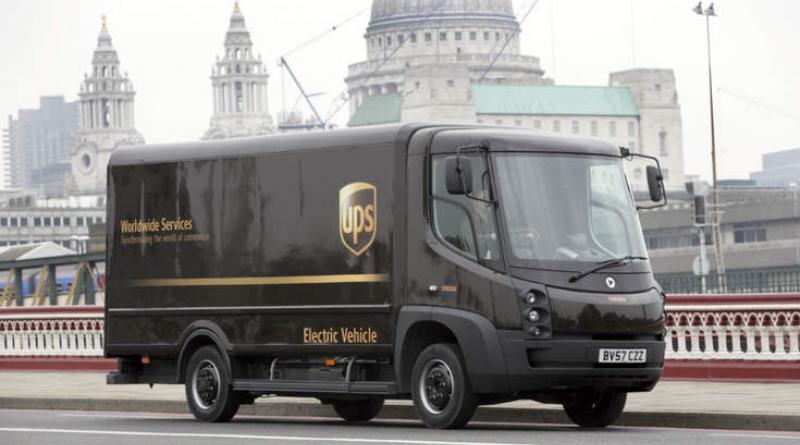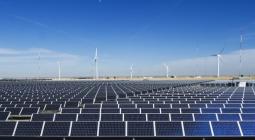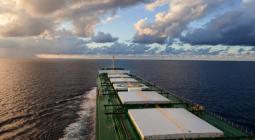Logistics leaders suggest quickest routes for decarbonizing shipping.

Globally, freight makes up about 15 percent of global energy demand, according to the green business advocacy group BSR. That’s a lot of fuel, but industry advocates in the transportation and logistics field are working hard to decarbonize while they still have time. At VERGE 2019,shipping industry leaders convened to discuss their plans, their challenges and their hopes for a radically different — and greener — delivery future.
The shipping industry has made big strides in recent years on fuel efficiency, determining better ways to go further on less.
But Mads Stensen, sustainability developer at multinational freight giant Maersk, said those sorts of efficiency innovations won't be enough to achieve the long-term goal. "Cutting emissions through efficiency is never going to bring us to zero," he said. “We have to do something radically differently."
Maersk has a goal of achieving carbon-neutral logistics by 2050, as does logistics company DHL, which was also at VERGE. Kathrin Brost, vice president of DHL’s Go Green Program, said: "We don’t know how we are going to reach carbon neutrality, but it’s the right thing to do."
Bringing large, multinational corporations that rely on fossil fuels to operate into a carbon-neutral future will be a long journey. At this point, biofuels are about three times as expensive as traditional fuels, Brost said.
The shipping industry is between two development curves — the industry is nearing a plateau on emissions that can be cut through efficiency, but the technology is still in development for being able to use zero-emissions energy sources at scale.
"Cutting emissions through efficiency is never going to bring us to zero. We have to do something radically differently."
Governments are still subsidizing fossil fuels, exacerbating the cost differential between clean and dirty fuels. "In an ideal world, we should not be subsidizing fossil fuels. We should be subsidizing biofuels," Stensen said. Earlier this month, Maersk partnered with agribusiness Cargill to develop and test new technologies with a view to continuing to accelerate progress on lowering emissions.
While some progress has been made on renewable energy through the Paris Agreement, the accord is designed for individual countries, leaving emissions from transport between them out. "The Paris Agreement is a great achievement, but each country is working on their own plan. Nobody owns international transport," Brost said.
It’s also difficult for shipping businesses to embrace zero-emissions transportation methods unless their customers support them, especially because in the short term a lower-emissions shipping option may cost them money, time or both.
"We need to find a way to engage with customers and help them understand the real impact of freight," said Sophie Punte, executive director of the Smart Freight Center, an NGO that works to reduce emissions from transport companies.
Despite the challenges, Brost, Stensen and other industry advocates are committed to decarbonization because of the impact that their companies can have by going carbon neutral; multinationals can wield a great deal of power. "We own 9-10 percent of the container shipping on earth, so we can really do something," Stensen said.
Multi-modal delivery can be a pathway to decarbonization. Companies working together have a better shot of success. "You can’t do this alone," Punte said.
Customer education also emerged during VERGE 19 as an important key to improving the chances of decarbonization success. The company informed consumers through an explanation in the site's shopping cart, marked with a leaf icon." Chelsea Mozen, sustainability director for e-commerce brand Etsy, said Etsy has had successful rollout of its "carbon neutral shipping plan" (carbon offsets for shipping), something it achieved by adding a leaf icon to the site’s shopping cart that customers can select. "Customers don’t understand the impact of emissions, but if you give them the option and the information, they care," she said. (While Etsy cannot directly control shipping because products are usually shipped directly from buyers to sellers, the company has committed to purchasing carbon offsets for 100 percent of the emissions generated by the shipping process.)
One company that has emerged as a pioneering leader in greening the transport space, in spite of challenges, is UPS. The company has a goal to reduce absolute greenhouse gas emissions by 12 percent by 2025, a goal it is well on its way to meeting through electric trucks and other alternative fuel vehicles in its "rolling laboratory," a fleet of advanced technology vehicles that now numbers over 10,000.
Peter Harris, director of international sustainability for UPS, said initially the company’s ambitious climate goals were driven by risk to its business, but it has seen other payoffs. "When you innovate to stay ahead of risk, that actually puts you ahead," he said.
The development of UPS’ electric fleet hit a roadblock in London when the company realized that it had a cap on the number of trucks it could charge simultaneously — so it looked to innovation to get around that limitation.
"One of the big challenges to electrifying our urban fleet is not only the obvious challenge of vehicle supply, but also the less expected challenge of power supply. It turns out in a lot of our buildings, we have power supply thresholds that we can’t go beyond without making some form of change to the building," Harris said.
At UPS’ central London location, that cap, even after purchasing an upgrade, only allowed plug-ins for 65 trucks. "A couple of years ago, when we started to push up against that new limit, we started to think ‘OK, there has got to be a better way of doing this," Harris said.
"We need to find a way to engage with customers and help them understand the real impact of freight."
UPS partnered with a local nonprofit and the area’s power supplier to form a new solution: a combined microgrid and energy storage unit that has allowed the company to electrify the entire building.
"It took our power capacity from what was 65 to now our entire fleet of 170, or even slightly beyond that, without any further upgrades. What’s important about that is that we have to get to a place, as a society, where the cost of deploying electric vehicles meets or beats the cost of deploying fossil fuel vehicles, in order that we can scale this opportunity. … This technology approach will be, for us, and I think for others, instrumental in meeting that threshold," Harris said.
Decarbonizing the shipping and logistics industry is a puzzle that advocates have far from, but multinational leaders have recognized that building a carbon-free future is worth their time and energy. "We are prepared to make an investment in the long term," Harris said.
29 October 2019
GreenBiz





